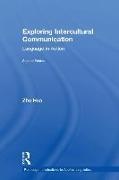Fr. 244.80
Zhu Hua
Exploring Intercultural Communication - Language in Action
Englisch · Fester Einband
Versand in der Regel in 1 bis 3 Wochen (kurzfristig nicht lieferbar)
Beschreibung
Exploring Intercultural Communication 2nd edition increases and updates the coverage on emerging key topics, including symbolic power, communicative turbulence, conversational inequality, stereotypes, racism, Nationality and Ethnicity talk, and the impact and role of technology in intercultural communication. Using global examples from a range of genres, this book is an indispensable resource for students taking language and intercultural communication modules within Applied Linguistics, TESOL, Education or Communication Studies courses.
Inhaltsverzeichnis
Contents
Acknowledgements
Permissions
Transcription Conventions
Series editors’ introduction
Notes on using this book
Part I
Intercultural communication in everyday life
1 Language Classrooms
1.1 Culture and language learning and teaching (Does learning a language mean learning a culture?)
1.2 Culture of learning (How many times do I need to practise?)
1.3 Multicultural classrooms (Why is she so quiet in the classroom?)
1.4 Chapter summary
2 The workplace
2.1 Meetings (Has anything been decided in the meeting?)
2.2 Small talk (Haven’t seen you for ages!)
2.3 Humour (I didn’t get that!)
2.4 Chapter Summary
3 Business
3.1 Advertising (Buy it, sell it, love it)
3.2 International business negotiation (Why do they talk a lot about nothing really?)
3.3 More language and communication matters (Dear Respected Mr Lin, How are you?)
3.4 Chapter summary
4 Family and Migration
4.1 Migrant families (I’m British on paper, but am I English?)
4.2 Intercultural couples (Can love speak without words?)
4.3 Language choice and learning at home (Good boy! Well done habeebi (my darling))
4.4 Chapter summary
5 Study abroad and tourism
5.1 Study abroad (Does ‘real’ experience help with my language and intercultural learning?)
5.2 Tourism (Can I take a picture with you?)
5.3 Chapter summary
Part II
Developing intercultural communicative competence
6 What are culture-specific ways of communication and why?
6.1 High versus low context: relationship and networks
6.2 High involvement: solidarity and connectedness
6.3 Directness or indirectness: face, politeness and rapport
6.4 Turn-taking: universals vs. cultural variations
6.5 Space: the silent language
6.6 Chapter summary
7 What causes turbulence in intercultural communication
7.1 Communicative turbulence
7.2 Symbolic power
7.3 Pragmatic mismatch
7.4 Clash of styles
7.5 Mismatch in schemas and cultural stereotypes
7.6 Mismatch in contextualisation and framing
7.7 Chapter summary
8 What contributes to successful communication?
8.1 Accommodating towards your audience
8.2 Negotiation as the way of engagement
8.3 Interpreting and mediating interaction
8.4 Understanding professional and institutional discourse
8.5 Chapter summary
9 How to develop intercultural communicative competence
9.1 ICC in foreign language teaching and learning
9.2 A multidisciplinary overview of ICC
9.3 Intercultural learning through education and training
9.4 Intercultural learning from a language socialisation perspective
9.5 Chapter summary
Part III
Understanding intercultural communication critically
10 The relation between language, culture and thought: the classical question
10.1 The Sapir-Whorf hypothesis: language controls or influences thought
10.2 Colour terms: language influences, but does not determine perception
10.3 ‘The geography of thought’: culture influences thought independent of language
10.4 Cultural key words: vocabulary as index of a culture
10.5 The language of thought: language as a window into human nature; and thought exists independently of language
10.6 The bilingual mind: thinking and speaking in two languages
10.7 Thinking back: relevance to intercultural communication
11 Theories of culture: a fundamental question
11.1 Compositional approach: culture as a collection of things shared by people.
11.2 Interpretive approach: culture as semiotic
11.3 Action approach: culture as a process
11.4 Critical approach: culture as power and ideological struggle
11.5 Overview: complexity of culture
11.6 Thinking back: from what culture is to what intercultural communication is
12 Language, identity and interculturality: a paradigm-shifting question
12.1 ‘Where are you from?’
12.2 Identity: multiplicity and types
12.3 Cultural identity
12.4 Interculturality: from being to doing cultural identities
12.5 Thinking back and looking forward
Task commentaries
Glossary of key terms
References
Index of subjects
Index of languages, cultures and geographical areas
Über den Autor / die Autorin
Zhu Hua is Professor of Applied Linguistics and Communication at Birkbeck, University of London, UK. She has published extensively on multilingual and intercultural communication and child language. She is forum and reviews editor of Applied Linguistics and joint series editor of Routledge Language and Intercultural Communication Series and Cambridge Key Topics in Applied Linguistics Series.
Produktdetails
| Autoren | Zhu Hua |
| Mitarbeit | Ron Carter (Herausgeber der Reihe), Guy Cook (Herausgeber der Reihe) |
| Verlag | Taylor & Francis Ltd. |
| Sprache | Englisch |
| Produktform | Fester Einband |
| Erschienen | 23.07.2018 |
| EAN | 9781138066847 |
| ISBN | 978-1-138-06684-7 |
| Seiten | 286 |
| Serie |
Routledge Introductions to Applied Linguistics |
| Thema |
Geisteswissenschaften, Kunst, Musik
> Pädagogik
> Schulpädagogik, Didaktik, Methodik
|
Kundenrezensionen
Zu diesem Artikel wurden noch keine Rezensionen verfasst. Schreibe die erste Bewertung und sei anderen Benutzern bei der Kaufentscheidung behilflich.
Schreibe eine Rezension
Top oder Flop? Schreibe deine eigene Rezension.

